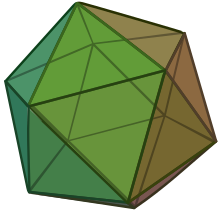

In geometry, a deltahedron (plural deltahedra) is a polyhedron whose faces are all (congruent) equilateral triangles. The name is taken from the Greek upper case delta letter (Δ), which has the shape of an equilateral triangle. There are infinitely many deltahedra. By the handshaking lemma, each deltahedron has an even number of faces. Only eight deltahedra are strictly convex; these have 4, 6, 8, 10, 12, 14, 16, and 20 faces.[1] These eight deltahedra, with their respective numbers of faces, edges, and vertices, are listed below.
There are eight strictly convex deltahedra: three are regular polyhedra and Platonic solids, five are Johnson solids.
In the 6-faced deltahedron, some vertices have degree 3 and some degree 4. In the 10-, 12-, 14-, and 16-faced deltahedra, some vertices have degree 4 and some degree 5. These five non-regular deltahedra belong to the class of Johnson solids: non-uniform strictly convex polyhedra with regular polygons for faces.
A deltahedron retains its shape: even if its edges are free to rotate around their vertices (so that the angles between them are fluid), they don't move. Not all polyhedra have this property: for example, if some of the angles of a cube are relaxed, it can be deformed into a non-right square prism or even into a rhombohedron with no right angle at all.
There is no 18-faced strictly convex deltahedron.[2] However, the edge-contracted icosahedron gives an example of an octadecahedron that can either be made strictly convex with 18 irregular triangular faces, or made equilateral with 18 (regular) triangular faces that include two sets of three coplanar triangles.
There are infinitely many cases with coplanar triangles, allowing for convex sections of the infinite triangular tiling. If the sets of coplanar triangles are considered a single face, a smaller set of faces, edges, and vertices can be counted. The coplanar triangular faces can be merged into rhombic, trapezoidal, hexagonal, or other polygonal faces. Each face must be a convex polyiamond, such as ![]() ,
, ![]() ,
, ![]() ,
, ![]() ,
, ![]() ,
, ![]() ,
, ![]() ,
, ![]() , ...[3]
, ...[3]
Some small examples include:
There are an infinite number of non-convex deltahedra.
Five non-convex deltahedra can be generated by adding an equilateral pyramid to every face of a Platonic solid:
Other non-convex deltahedra can be generated by assembling several regular tetrahedra:
Like all toroidal polyhedra, toroidal deltahedra are non-convex; example:
When possible, adding an inverted equilateral pyramid to every face of a polyhedron makes a non-convex deltahedron; example:
Like all self-intersecting polyhedra, self-intersecting deltahedra are non-convex; example: